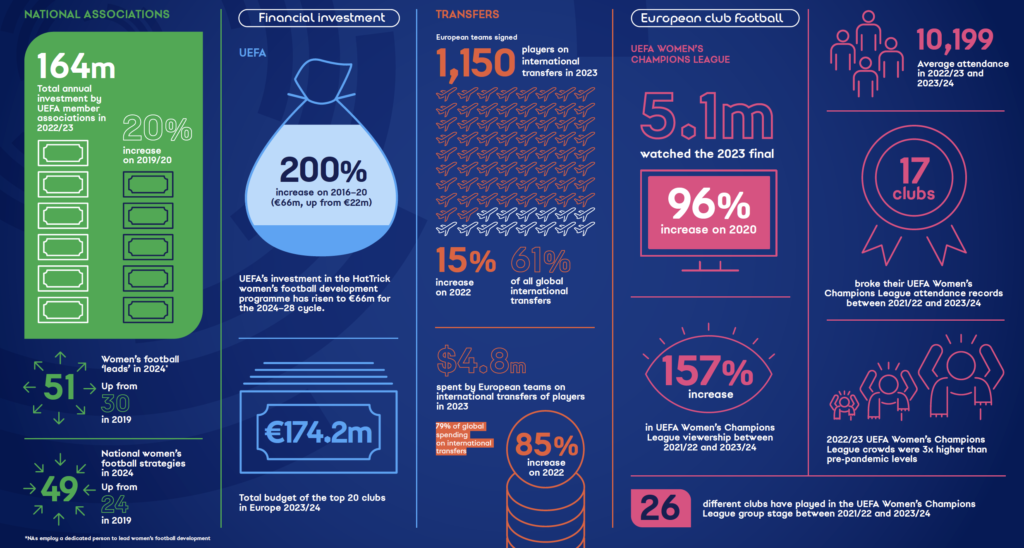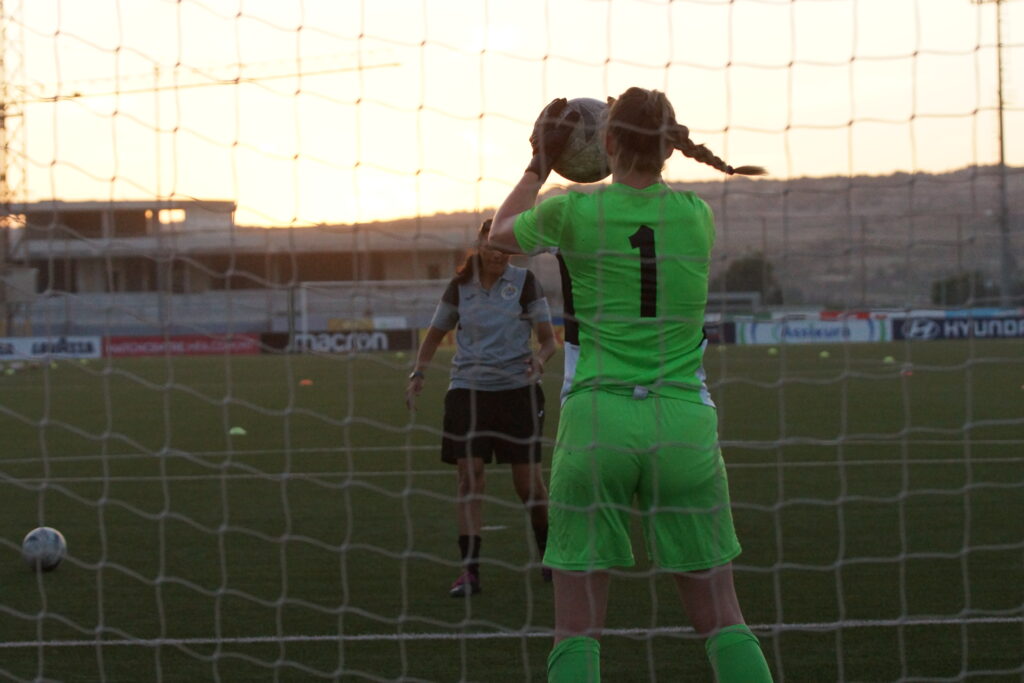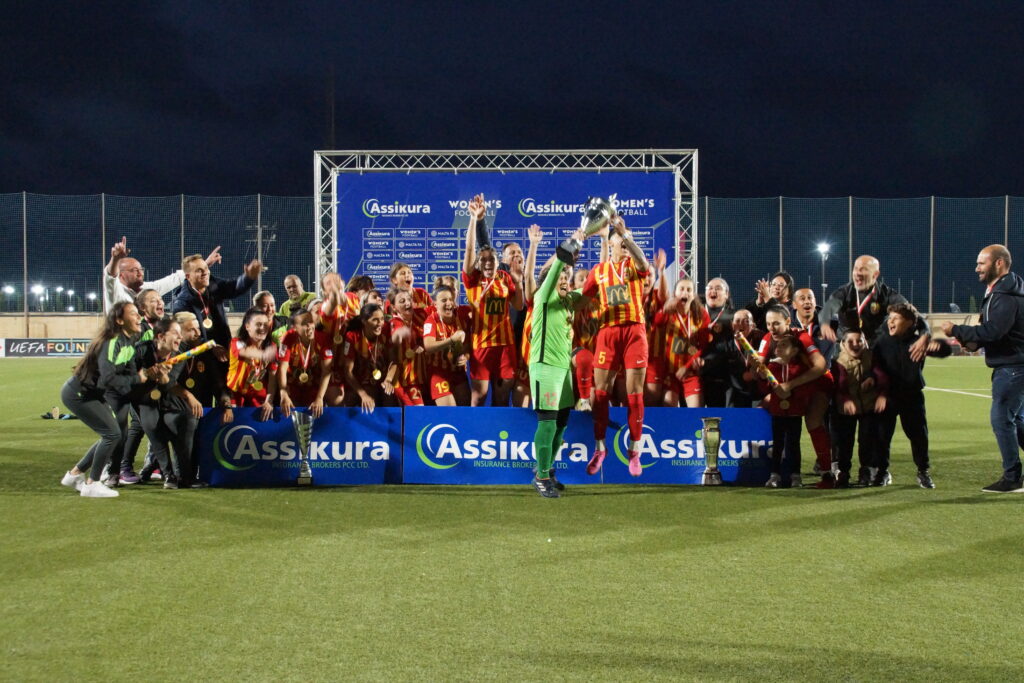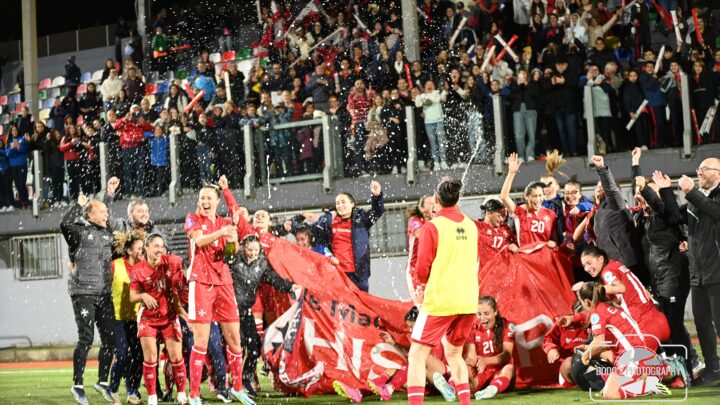The Malta Football Association general election was held eight months ago to the day, however the much touted women’s football strategy is yet to be published. In contrast, UEFA has published its latest ambitions to 2030 as the ‘Unstoppable’ women’s football strategy.
This long-read article looks at the potential reason for the lack of a published strategy for Malta thus far, and why that might not be the worst thing, despite time lost. Most importantly, it kick-starts a series diving into the pillars set by UEFA in its latest strategy, while addressing the gaps that Malta’s Women’s Football Strategy must consider if it has ambitions to lift the women’s game. The series is drafted following months of discussion with various stakeholders.
Eight Months Passed & No Strategy – And Maybe That’s A Good Thing
It has been eight months to the day since the Malta Football Association (MFA) Elections took place, re-electing Bjorn Vassallo at the helm, supported by three vice-presidents in Dr Matthew Paris, Dr Maria Azzopardi and Adrian Casha.
Plenty of things grabbed attention in the lead-up as contestants fought for votes. While plenty of negatives were brushed under the Covid-19 impact umbrella, the pride in the women’s national team was never so apparent than during those times. Fresh off the triumphs securing promotion at the first time of asking in the UEFA Women’s Nations League, the women’s national team, led by Manuela Tesse and her staff, proved that it could achieve things.
Paired with the political speeches celebrating those triumphs and the incessant underlining of the support given to the women’s football, was the promise of a women’s football strategy meant to lift Malta’s women’s game to the next stage.
The preparation of the Malta Women’s Football Strategy was led by Dana Farrugia, who at the time held the role of Women’s Football representative on the executive board. She departed the post following the election having failed to secure the Vice President seat. However, that was March. Eight months have elapsed and the talk of the women’s football strategy has quietly disappeared from the public eye.
While that may seem negative, the questions posed by The Sporting Fan to several individuals in the lead-up to the election, who had a hand in creating and or had knowledge of the contents of the touted Strategy, did not convince much. While revealing the knowledge gained regarding the contents of that draft is not possible, perhaps that draft never seeing the light of day is not the worst situation.
To be clear, it is not to say that it is to be discarded or that it is all wrong, but from discussions things pointed toward easy wins, a tunnel vision and a lack of ambition, the opposite of all that a strategy is meant to do. In other words, one hopes that the delay is only due to the realisation of those involved that women’s football deserves more than what that strategy would have provided.
While The Sporting Fan understands that the intention to publish a Strategy is there, efforts to obtain details regarding its publication in the past months have yielded limited information and no concrete timelines.
UEFA Paves The Way With ‘Unstoppable’ Strategy To 2030, But Malta Must Work Harder
In the time that has passed since then, UEFA has closed off it’s ‘Time For Action’ Women’s Football Strategy for the 2021-24 years, and has recently launched the ‘Unstoppable’ Women’s Football Strategy, meant to set the target and path for the next six years (until 2030).
As those preceding it, the strategy sets goals, evaluation methods and financial investment down the pyramid, combined by an inspiring message that is meant to motivate women’s football stakeholders into action. The great thing about it is that it’s four pillars touch major areas which Malta needs to improve on.
However, for Malta, the work in the next few years must span wider. Malta must take the initiative to tackle others on its own, because as Europe’s top leagues rush forward, Malta must do the work they have done before, of their own volition, to make up the already lost ground in having undervalued its women’s football sector while others abroad recognised its value.
The first thing to keep in mind is that Malta should maximise its portion from the 66 million Euro that UEFA is investing via its HatTrick Programme to develop women’s football, aimed at raising the standards of national teams, domestic leagues and clubs. The second important thing is to make sure that the money is truly invested in the women’s game and not funnelled elsewhere. Here is where the much-talked-about transparency is pivotal.

With the assumption that the stakeholders will guard the women’s game and give it its due priority, all eyes turn toward where the improvements are to be made, i.e. the four pillars set by the UEFA Strategy of: Competitions & Professionalisation, Participation & Talent Development, Investment & Commercialisation, and Fan Culture.
Each of these will be dove into within a series of articles with the Maltese context in mind. This in attempt to put a spotlight on the additional nuances of Malta’s women’s game that require attention and that are likely to be overlooked by the UEFA strategy due to the specific circumstances of a nation.
Any points mentioned are compiled following discussions held with various stakeholders involved in the game, spanning coaches, players, administrators, supporters and parents in Malta. Discussions were also held with individuals consulting for foreign Football Associations, as well personnel operating in the football scenes in other countries, paired with individual observations of progress made in other countries. Underlining all of this are the observations made simply through following the football sector in Malta with a specific eye on women’s football.
All of this with the intention of presenting the widest possible viewpoint to the reader and provide a platform for wider discussion. It is accepted that there will always be other viewpoints and elements to be considered.
The first pillar pertains to ‘Competitions & Professionalisation’.
Competitions & Professionalisation
UEFA has made clear its intention to continue pushing for professionalisation and a sustainable women’s game. The European body will continue to invest in its already trailblazing UEFA Women’s EURO and UEFA Women’s Champions League competitions, while launching a second European competition.
It is up to the Maltese football community to prepare its players to continue the positive strides made in recent years in the European territory by Hibernians and later Birkirkara. Furthermore, it is already known that competing requires qualified coaches and clubs licensing structures that require investment up front.
Defining Baseline & Pathway For The Improvement Of Coaching, Administrative & Officiation Structures
By contrast, the Assikura Women’s League gives plenty of leeway to competing clubs. While there are basic qualification requirements for a coach, there is a lot to be desired from every other aspect. So, one would expect the Strategy to set a relevant basic requirement for a technical staff setup, administrative setup and also the referee officials. Most importantly, it should also set a clear pathway toward elevating this from a basic requirement to higher levels in the next few years.
Providing an early roadmap ensures that all involved can be prepared to navigate the improvement steps required. Doing so would elevate the domestic league, which in turn bridges the gap to the European stage. Dove-tailing on this would be the elevation of the quality of Malta Women’s National Team.
In terms of coaching, more than half of the clubs competing in the league have taken it onto themselves to implement a coaching staff around the women’s team consisting of at least a coach, assistant coach and physical trainer. Goalkeeping coaches, technical analysts, physios and other medical personnel are not always present and this is something that still needs addressing.
However, not all clubs have done this to the same degree and there are still several coaches involved in the women’s game who have next to no qualification. This is in breach of the existing basic requirements set for the coach of a team competing in the Assikura Women’s League, but there in lies another crucial aspect of a Strategy. There is no point setting a target, if there is no means to evaluate and by extension if there is no appetite or resources to do so.
While encouraging aspiring coaches to get involved is important and everyone must start somewhere, if there is the true value of growing the women’s game, the Strategy should set a paradigm shift from treating it as a training ground for aspiring coaches or referees, to something that deserves a level of quality. It must stop the rhetoric of women’s football as a side-show for those wanting to do a hobby without any interest in investing themselves into growing it and elevate the respect toward it.

As has been said multiple times in other articles and discussions, a football team is not only dependent on coaches and players. It also requires supporting and administrative staff such as team managers, kit managers, media officers and administrators, among other more nuanced roles.
Ensuring that these people have the right know-how and understanding of their roles within the football setting, will enable improved club performances since several clubs still rely heavily on coaches and players to do support several of these tasks. Thus, organising exchanges and training for these supporting personnel, with a critical baseline requirement is crucial too.
Having dedicated and qualified personnel will ensure more time for specialised individuals to focus on their work, while also improving dialogue toward a unified effort to raise the women’s game. It is no secret, the skills required from an administrator are very different to those of a football coach.
As mentioned above, there is no point in setting requirements for clubs to improve their coaching and administration structures, unless the officials in the matches are also improving at the same rate. The game is already getting hindered by poor officiation where simple laws of advantages and offside calls are butchered to the eyes of the simplest football fan.
Speaking to several players and coaches involved confirmed their lack of trust in setting up more complicated passages of play simply due to knowing that the officials will make wrong judgement calls. Before discussing VAR, the first basic should be to ensure that an acceptable level of officiation is achieved through adequate training. The game is not only dependent on clubs’ coaches and players, officials have an important role to play.
Setting these requirements will safeguard the women’s game from individuals who could dismantle the current progress, improve the playing field among clubs, and ensure that players have the necessary structures around them. This is crucial to set a course to reach the countries who are galloping out front.
Revamping Competitions Toward Sustainable Professionalisation
Once coaching, player and administration structures are defined and monitored, the next element to consider is the purpose of why any single club should be interested in investing to improve them.
The women’s game in Malta still currently involves a number of passionate individuals, many of whom involve themselves simply due to their love for the game. However, while officially the women’s game is amateur in Malta, there is a growing concern of imbalances between clubs who have taken it upon themselves to incentivise players. Swieqi United have gone public with a tiered structure on professionalising their players. While other clubs have not been so public, those involved are well aware of sums of money being exchanged.
It is not a negative thing, but the lack of regularisation will send the women’s game down the same rotten path as the men’s if there is no effort to ensure sustainability. This is where governance is a must and where it must be paired by incentives in competitions. The point of all of this is that one must keep the passion but give it the necessary pathway to thrive into bigger and more ambitious territory.
It is no secret that for those involved in Malta, the only incentive is to win the Assikura Women’s League, not for the sake of it, but because it gives the opportunity to compete in the UEFA Women’s Champions League and that brings financial benefit. The introduction of a second European competition will inject more energy into teams to fight for something. However, Malta’s competitions leave much to be desired.
Pushing aside the Assikura Women’s League, the only incentive for anyone to compete in the Super Cup or the Knockout is currently the joy of lifting a trophy. While admirable, there must be an ambition to give clubs competing in the Knockout an incentive to try beyond this. Furthermore, for the football fan in the stands, a year of watching the same eight teams competing, some of whom will have already met five times, makes this quite a boring watch no matter how passionate the teams are.
In the spirit of improving every aspect of the game and gaining the right sponsorships to incentivise teams, some thinking out of the box can be done to inspire life into this otherwise dead competition. One idea could be to invite a number of teams from other countries of similar levels to a new competition. It would inject interest, new sponsorships, new viewers and give teams a run for their money against new opposition while also give them better chances of being prepared for the UEFA competitions. Several ideas could be explored, but the point remains that some thinking outside the box is required if the game is to go to a new level.

Youth Pathways & Competitions
A final word in regards to the competitions requires giving attention to the Youth Leagues and youth player movement. The discussions revolving the Assikura Women’s Youth League (U19) and BNF U16 National League continue to prevail. Besides the importance of setting structures and pathways for these too, as listed above, they require further investigation.
The football in the leagues remains on the general part poor, so a closer look is required to understand all the elements going into this, part of which relates to the ‘Development’ pillar which will be further discussed in a follow-up article.
Paired with this are the small numbers and the need to recognise the burn-rate that several players are going through by playing in multiple leagues. League structures must be analysed in reference to this. Furthermore, several players are still getting lost in transition to the senior league, and that warrants some discussion around the regulations of these leagues and whether they are truly serving the growth of the game in Malta.
This season’s introduction of the U13 league has gotten little fanfare but is a step toward engaging more youngsters into the competitive side of the game at an early age. The Strategy could set the next steps in grassroots to ensure that this league is kept on par with improvements to lift the sector altogether, while ensuring that the focus at that age remains on development.
However, once again, the importance here lies in regulation, not just on the competition but in how players move within clubs. Especially considering the fees being charged for young players to be enrolled in club academies and the surrounding issues that have been raised in the past when players want to move, regulation must be treated with the sense of maximising the potential of players staying in the game.
Final Word
One final element that overarches all of this, is the Women’s Football Department within the Malta Football Association itself. The individuals involved have paved the path for the successes that women’s football in Malta has managed to achieve. There is no doubt that they will continue to put blood, sweat and tears for the game to continue to grow. However, one cannot believe that the Association takes the growth of women’s football seriously unless it starts injecting the needed support, in people and finances, within its own house if the game is to grow.
Paired with this is the nurturing of the ever important link between all stakeholders, including clubs, supporters and media. If all stakeholders move away from current mentalities and replace them with an effort to understanding the duties of each stakeholder, that will go a long way to ensure that they all balance each other for the game to grow. A well-written Strategy, consulted with the relevant stakeholders and backed by the right energy, has the potential to do just that.
Stay tuned for the second part which will deal with Participation & Talent Development.
Lead Image: Dorienne Grech
Make sure to never miss an Assikura Women’s League match by syncing your calendar here.
Stay up to date by following The Sporting Fan on social media: Instagram ~ Facebook ~ X




2 Responses
[…] introduced the Talking Strategy series by throwing first spotlights into what the Women’s Football Strategy for M…, this second part deals with Participation & Talent Development: of players, coaches and […]
[…] of the Talking Strategy Series pertain to investment, commercialisation and fan culture. While Part 1 and 2 dealt with the technical side of investment, regularisation and competition structures, and […]